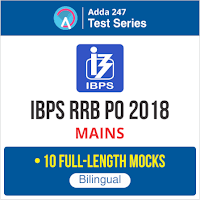Directions (1-5): निम्नलिखित जानकारी का ध्यानपूर्वक अध्ययन कीजिए और नीचे दिए गए प्रश्नों के उत्तर दीजिए.
व्यक्तियों की एक निश्चित संख्या एक पंक्ति में उत्तर की ओर उन्मुख होकर बैठे हैं। A और G के मध्य बैठे व्यक्तियों की संख्या G और D के मध्य बैठे व्यक्तियों की संख्या के समान है। A और D, B के बायें ओर है और चार से कम व्यक्ति उनके मध्य नहीं बैठे। B के बायें ओर आठ व्यक्ति बैठे हैं। H, G के ठीक बायें ओर है। E और C के मध्य दो व्यक्ति बैठे हैं, जो F के दायें ओर तीसरा है। B और F के मध्य केवल एक व्यक्ति बैठा है। D और E के ठीक दायें ओर व्यक्ति के मध्य 10 से अधिक व्यक्ति नहीं बैठे।
Q1. पंक्ति में कितने व्यक्ति बैठे हैं?
The number of persons sitting between A and G is same as between G and D. A and D are left to B and not less than four persons sit between them. Case2 gets eliminated. H is immediate left to G.
Not more than ten sit between D and the one who is immediate right to E. The final arrangement is:
Q2. A और B के मध्य कितने व्यक्ति बैठे है?
Eight persons are sitting to the left of B. Two persons sit between E and C, who is 3rd right to F. Only one person sits between B and F. There will be two cases ; case 1 F is right to B and case2 F is left to B.
The number of persons sitting between A and G is same as between G and D. A and D are left to B and not less than four persons sit between them. Case2 gets eliminated. H is immediate left to G.
Not more than ten sit between D and the one who is immediate right to E. The final arrangement is:
Q3. यदि X, H और D के ठीक मध्य में बैठा है, तो निम्नलिखित में से कौन X के दायें ओर चौथे स्थान पर बैठा है?
Eight persons are sitting to the left of B. Two persons sit between E and C, who is 3rd right to F. Only one person sits between B and F. There will be two cases ; case 1 F is right to B and case2 F is left to B.
The number of persons sitting between A and G is same as between G and D. A and D are left to B and not less than four persons sit between them. Case2 gets eliminated. H is immediate left to G.
Not more than ten sit between D and the one who is immediate right to E. The final arrangement is:
Q4. D के संदर्भ में C का स्थान क्या है?
Eight persons are sitting to the left of B. Two persons sit between E and C, who is 3rd right to F. Only one person sits between B and F. There will be two cases ; case 1 F is right to B and case2 F is left to B.
The number of persons sitting between A and G is same as between G and D. A and D are left to B and not less than four persons sit between them. Case2 gets eliminated. H is immediate left to G.
Not more than ten sit between D and the one who is immediate right to E. The final arrangement is:
Q5. यदि Z, G के बायें से 5वां है, तो A और Z के मध्य कितने व्यक्ति बैठे हैं?
Eight persons are sitting to the left of B. Two persons sit between E and C, who is 3rd right to F. Only one person sits between B and F. There will be two cases ; case 1 F is right to B and case2 F is left to B.
The number of persons sitting between A and G is same as between G and D. A and D are left to B and not less than four persons sit between them. Case2 gets eliminated. H is immediate left to G.
Not more than ten sit between D and the one who is immediate right to E. The final arrangement is:
Directions (6-7): निम्नलिखित जानकारी का ध्यानपूर्वक अध्ययन कीजिए और दिए गए प्रश्नों के उत्तर दीजिए।
यदि ‘P × Q’ का अर्थ है P,Q की बहन है।
यदि ‘P – Q’ का अर्थ है P,Q का पुत्र है।
यदि ‘P ÷ Q’ का अर्थ है P,Q की पुत्री है।
यदि ‘P + Q’ का अर्थ है P,Q का पति है।
Q6. दिए गए व्यंजक M÷R+S×U-W में, R, W से किस प्रकार संबंधित है?
Q7. निम्नलिखित में से किस व्यंजक का अर्थ है ‘F, A की आंट है?
Directions (8-12):निम्नलिखित जानकारी का ध्यानपूर्वक अध्ययन कीजिए और दिए गए प्रश्नों के उत्तर दीजिए।
निम्नलिखित व्यवस्था के अनुसार आठ व्यक्ति दो समांतर पंक्तियों में बैठे हैं.
एक कंपनी में अलग अलग पद पर व्यक्ति अर्थात्: जीएम, डीजीएम, एजीएम, सीएम, एसएम, प्रबंधक, अधिकारी, क्लर्क हैं। पद वरिष्ठता के अवरोही क्रम में उल्लिखित है। व्यक्ति जो ठीक वरिष्ठ या ठीक कनिष्ठ है समान पंक्ति में नहीं बैठे या एक दूसरे की ओर उन्मुख है
सबसे वरिष्ठ व्यक्ति तीसरे सबसे कनिष्ठ व्यक्ति की ओर उन्मुख है। दूसरा सबसे कनिष्ठ व्यक्ति चौथे सबसे वरिष्ठ व्यक्ति की ओर उन्मुख है। सीएम और डीजीएम के मध्य केवल एक व्यक्ति बैठा है। सबसे कनिष्ठ व्यक्ति न तो दक्षिण की ओर उन्मुख है और न ही किसी छोर पर बैठा है। दायें छोर पर बैठे व्यक्ति एक दूसरे के निकटतम पद पर है। वह जो अधिकारी है बायें छोर से तीसरा है।
Q8. क्लर्क के ठीक दायें ओर व्यक्ति का पद क्या है?
The ones sitting at right ends are at immediate designation to each other. So, there will be one more case in both the cases i.e. in one AGM sitting in the right most end and other in which GM sitting in right most end. The senior most person faces the 3rd most junior person.
The persons who are immediate senior or immediate junior do not sit in same row or face each other.
The junior most person neither faces south nor sits at any end. So, case2(a) case2(b) and case1(b) gets eliminated.
Q9. पंक्ति 1 में बायें छोर पर बैठे व्यक्ति का पद क्या है?
The 2nd most junior faces the 4th most senior person. The one who is officer is 3rd from the left end. Only one person sits between the one who is CM and the one who is DGM.
The ones sitting at right ends are at immediate designation to each other. So, there will be one more case in both the cases i.e. in one AGM sitting in the right most end and other in which GM sitting in right most end. The senior most person faces the 3rd most junior person.
The persons who are immediate senior or immediate junior do not sit in same row or face each other.
The junior most person neither faces south nor sits at any end. So, case2(a) case2(b) and case1(b) gets eliminated.
Q10. एसएम और अधिकारी के मध्य कितने व्यक्ति बैठे हैं?
The 2nd most junior faces the 4th most senior person. The one who is officer is 3rd from the left end. Only one person sits between the one who is CM and the one who is DGM.
The ones sitting at right ends are at immediate designation to each other. So, there will be one more case in both the cases i.e. in one AGM sitting in the right most end and other in which GM sitting in right most end. The senior most person faces the 3rd most junior person.
The persons who are immediate senior or immediate junior do not sit in same row or face each other.
The junior most person neither faces south nor sits at any end. So, case2(a) case2(b) and case1(b) gets eliminated.
Q11. निम्नलिखित में से चार एक समूह से संबंधित है कौन सा उस समूह से संबंधित नहीं है?
The 2nd most junior faces the 4th most senior person. The one who is officer is 3rd from the left end. Only one person sits between the one who is CM and the one who is DGM.
The ones sitting at right ends are at immediate designation to each other. So, there will be one more case in both the cases i.e. in one AGM sitting in the right most end and other in which GM sitting in right most end. The senior most person faces the 3rd most junior person.
The persons who are immediate senior or immediate junior do not sit in same row or face each other.
The junior most person neither faces south nor sits at any end. So, case2(a) case2(b) and case1(b) gets eliminated.
Q12. निम्नलिखित में से कौन एसएम की ओर उन्मुख है?
The 2nd most junior faces the 4th most senior person. The one who is officer is 3rd from the left end. Only one person sits between the one who is CM and the one who is DGM.
The ones sitting at right ends are at immediate designation to each other. So, there will be one more case in both the cases i.e. in one AGM sitting in the right most end and other in which GM sitting in right most end. The senior most person faces the 3rd most junior person.
The persons who are immediate senior or immediate junior do not sit in same row or face each other.
The junior most person neither faces south nor sits at any end. So, case2(a) case2(b) and case1(b) gets eliminated.
Directions (13-15): निम्नलिखित जानकारी का ध्यानपूर्वक अध्ययन कीजिए और दिए गए प्रश्नों के उत्तर दीजिए।
यदि A>B का अर्थ है A, B से बड़ा नहीं है
A=B का अर्थ है A, B से बड़ा या बराबर नहीं है
A≤B का अर्थ है A, B से छोटा नहीं है
A≥B का अर्थ है A, B से छोटा या बराबर नहीं है
A<B का अर्थ है A, B से बड़ा या छोटा नहीं है
Q13. कथन: A = L < T ≥ R >H ≥ K
निष्कर्ष: I. H ≥ L II. K ≥ T
(I) H ≥ R < T = L [False] (II) T > R ≤ H > K [False]
Q14. कथन: P ≤ N ≥ D ≤ G = B > J
निष्कर्ष: I. G = P II. G = J
Q15. कथन: Q > E = I ≥ N < R ≤ S
निष्कर्ष: I. E ≤ S II. S > N
(I) E < I > N = R ≥ S [False] (II)N = R ≥ S [True]














